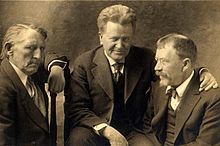- Seamen's Act
-
 Senator La Follette (center), with maritime labor leader Andrew Furuseth (left) and muckraker Lincoln Steffens, circa 1915.
Senator La Follette (center), with maritime labor leader Andrew Furuseth (left) and muckraker Lincoln Steffens, circa 1915.
The Seamen's Act, formally known as Act to Promote the Welfare of American Seamen in the Merchant Marine of the United States (Act of March 4, 1915, ch. 153, 38 Stat. 1164) was designed to improve the safety and security of United States seamen.
"The 1915 statute ... has been described as the Magna Carta of sailors' rights."[1]
Contents
Origins of the act
The Act was sponsored in the United States Senate by Robert Marion La Follette.[2] The International Seamen's Union (ISU) had significant influence on the drafting of the Bill, with the President of the Union, Andrew Furuseth, cited as being behind the intent and content of the bill. Secretary of Labor William B. Wilson supported its passage.
The Act was designed to promote the living and working conditions of seamen serving in the United States Merchant Marine. It applied to vessels in excess of 100 gross tons, excluding river craft.
Provisions of the act
The Act included provisions, inter alia, to:
- abolish imprisonment for desertion
- reduce penalties for disobedience
- regulate the working hours of seamen both at sea and in port
- establish a minimum quality for rations supplied to seamen
- regulate the payment of wages to seamen
- set safety requirements, including the provision of lifeboats
- require a minimum percentage of the seamen aboard a vessel to be qualified able seamen
- require at least 75% of the seamen aboard a vessel to understand the language spoken by the officers
Trade unions like the ISU provided much of the impetus for the bill, further promoted by the increasing international tensions in the years preceding World War I. The bill was first proposed in 1913, but became law after the beginning of hostilities in Europe, though before the United States joined the conflict. The sinking of the RMS Titanic in 1912 raised the issue of safety at sea as a political issue as well.
Later legislation
The Act did little to help seamen who were injured in the course of their duties, and the Merchant Marine Act of 1920, commonly known as the Jones Act, was passed in an attempt to address such incidents.
Notes
- ^ Marquis, Greg (2007). "Brutality on Trial (review)". Law and Politics Book Review. http://www.bsos.umd.edu/gvpt/lpbr/subpages/reviews/gibson0107.htm. Retrieved Mar. 25, 2010.
- ^ Eastlands Memorial Society
References
- "Seamen's Act". U.S. History.com. Florence, Oregon: Online Highways. http://www.u-s-history.com/pages/h990.html. Retrieved June 12, 2010.
- Marquis, Greg. "Review of E. Kay Gibson, 'Brutality on trial: Hellfire Pedersen, Fighting Hansen, and the Seamen's Act of 1915'". University of Maryland. http://www.bsos.umd.edu/gvpt/lpbr/subpages/reviews/gibson0107.htm.
External links
- Williams, James H (September 29, 1917). "A Better Berth for Jack Tar". The Independent (New York: S.W. Benedict) 91: 502–503, 515. http://books.google.com/books?id=wLfPAAAAMAAJ&dq=%22bucko%20mate%22&lr=&pg=PA502#v=onepage&q=%22bucko%20mate%22&f=false. Retrieved March 24, 2010. – Article by an Able Seaman describing the Seamen's Act and conditions for seafarers
Laws relating to the United States Merchant Marine 1870s 
1880s Dingley Act1890s 1910s Seamen's Act1920s Jones Act • Death on the High Seas Act of 19201930s Current Categories:- 1915 in law
- United States federal admiralty and maritime legislation
Wikimedia Foundation. 2010.
